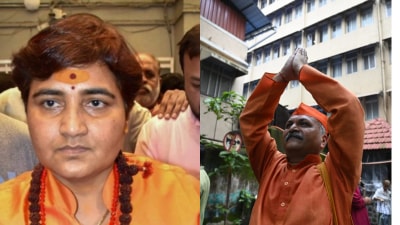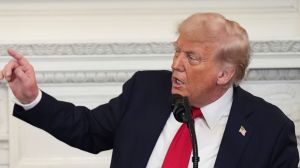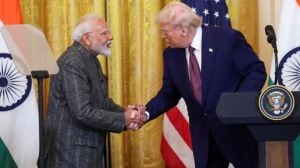Know Your City: From university to museum, Sir M Visvesvaraya left a trail of memories for Bengalureans to celebrate him
Known as the first Indian civil engineer, Sir M Visvesvaraya was the 19th Diwan of Mysore. He founded University Visvesvaraya College of Engineering (UVCE).
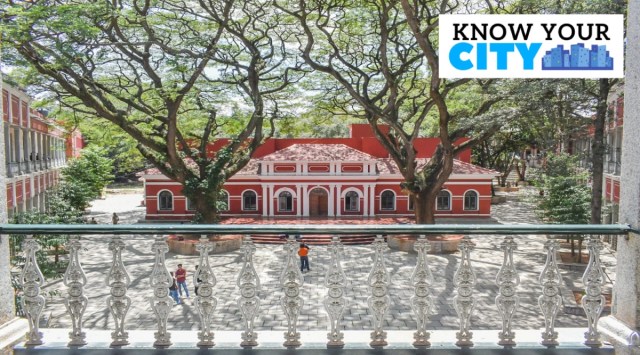 University Visvesvaraya College of Engineering (Express photo by Jithendra M)
University Visvesvaraya College of Engineering (Express photo by Jithendra M)September 15, the birthday of Sir M Visvesvaraya, is celebrated as National Engineer’s Day. While the work of the 19th Diwan of Mysore, known as the first Indian civil engineer, is out there for everyone to see and learn, there are some iconic landmarks in Bengaluru to celebrate him and remember him for his contributions to the engineering world.
One such establishment is the Visvesvaraya Industrial and Technical Museum, right in the heart of the city at Kasturba Road inside Cubbon Park. According to the 10-year annual report between 1965-75 archived in the library of the museum, a society called the Visvesvaraya Industrial Museum Society was formed through the help of various organisations and the central and state governments.
 Visvesvaraya Industrial and Technical Museum (Express photo by Jithendra M)
Visvesvaraya Industrial and Technical Museum (Express photo by Jithendra M)
The building altogether contains 40,000 sq ft of space on four floors together with a basement of 2,500 sq ft for housing a workshop. To give the museum a national character, the society offered the building to the Council of Scientific and Industrial Research (CSIR) in 1962 for setting up an industrial and technological museum.
Soon after taking over the building, the CSIR constituted a planning committee and prepared a master plan for the museum. The first task in setting up the museum was to create infrastructure so that models and exhibits could be planned, designed and fabricated within the museum itself.
As electricity plays an important role in the day-to-day life of citizens, the museum thought it appropriate to start its first gallery on the theme ‘electrotechnic’. The gallery was divided into three different sections; the first section dealing with the principles of electricity and magnetism, the second with telephony and the third dealing with the application of electronics in industries. This first gallery was inaugurated by former prime minister and then Union minister for information and broadcasting Indira Gandhi on July 27, 1965.
Since then the museum has evolved over the years with chief curators introducing engineering and space science-related exhibits making it interactive and more experiential. In fact, the archival material also highlights that the first 10 years of the museum witnessed a footfall of nearly 55 lakh. As of 2022, museum officials witness an annual footfall of around 10-11 lakh.
 Marut Aircraft installed near the entrance of the museum. (Express photo by Jithendra M)
Marut Aircraft installed near the entrance of the museum. (Express photo by Jithendra M)
The museum welcomes you with the engine hall, the dinosaur enclave and a replica of the famous Wright Brothers’ aeroplane spread across a vast space. The museum is also equipped with an electro-technic gallery, fun science, space technology gallery, biotechnology gallery, science for kids, BEL- hall of electronics, 3D show, and science park among others.
The latest addition to the museum is Seeds of Culture, an exhibition that provides an overview of the influences of Indian traditional knowledge in botany and medicine in the global context.
The museum is also home to the oldest steam engine in Bengaluru, built in 1888-89 by Dubs and Co, Glasgow. It belonged to the erstwhile Mysore state railway, then the Madras and Southern Mahratta Railway, and is now with the Southern Railway. It was last operated between Mysore and Ashokapuram.
Facing the road is a Marut Aircraft installed near the entrance of the museum. The Hindustan Aeronautics Ltd Marut was the first Indian attempt at an indigenous jet fighter aircraft design since separating from British rule. The Marut was the first design that was produced for the Indian Air Staff in the 1950s.
UVCE shapes bright engineers
Swami Vivekananda once said, “Education is the manifestation of perfection in an individual.” In fact, it is in this context that the University Visvesvaraya College of Engineering (UVCE) in KR Circle set out to shape bright and sharp intellectuals in the engineering world. According to the university’s centenary souvenir ‘Niranthara’, the story of the UVCE dates back to the series of events that unfolded since the famine of 1882 in Mysore state.
To give relief to the public affected by the great famine of 1882, rural irrigation and other projects, including the laying of the railway line between Bangalore and Mysore, were undertaken. Mysore state was well known for irrigation works and most of the engineering in the public works department was manned by importing some engineering from outside the state.
To meet the increased demand for engineers and to give an opportunity to the students of Mysore, a college of science was started and engineering was taught there. It was wound up after training a batch or two. In addition, there were several industry-related activities, including mills, mining and setting up metre gauge and narrow gauge lines, among others, undertaken. Visvesvaraya, who was appointed as the Diwan, submitted proposals for the rapid development of irrigation and power resources of the state and for starting industries and enlarging communication systems.
These activities in the new field of industry gave rise to a great demand for skilled workers and supervisors. To meet this demand, the government started a mechanical engineering school in Bangalore with the late SV Shetty as its superintendent around 1913. He was later deputed to the electrical department and hence lent to the education department.
To give a fillip to higher education and to enable Mysore students to play their part in the engineering field, Mysore University was founded in 1916 as a unitary type. Along with the birth of the university, a college of engineering was also established in Bengaluru in 1917, as some facilities regarding accommodation and work had already existed at the school of engineering.
According to the government order, the college was only temporarily located in Bengaluru. To start with, tuition and training were given only in two branches of engineering- civil and mechanical engineering.
In fact, the setting up of the university faced many setbacks and efforts were made to thwart the attempt from several influential quarters. However, the proposal for the university had the stamp of Visvesvaraya all over it with the strong backing of then Maharaja of Mysore Krishna Raja Wodeyar.
The mechanical engineering school was started in 1913. The required buildings were set up between Cenotaph Road and the post office road. This was the beginning of the present main building of the college facing the Krishnarajendra Circle. The central portion now housing the library was also put up at that time and some structures were erected to house shops, smithy and carpentry.
Earlier, the electrical department had set up buildings and a car barn as part of a plan to run a tramway service in the city. Necessary equipment had been ordered and even shipped from the USA for this historic interest. Unfortunately, the famous German raider Emden had torpedoed the ship during the First World War, thus sinking the plans into the sea forever. KR Seshachar, an illustrious alumnus of the Madras University, was appointed as the first principal. He modelled the courses on the Madras pattern with some modifications.
Later, in 1917, the institution was converted to a full-fledged engineering college under the name Government College of Engineering and was affiliated with the University of Mysore. It is the fifth engineering college to be established in the country and the first in Karnataka. In 1964, the affiliation of the college changed from Mysore University to Bangalore University.
In 1971, the college was renamed Visvesvaraya College of Engineering and in 1972, it was again renamed to University Visvesvaraya College of Engineering. The same year, the institution also started evening college in electronics engineering courses.
The city campus, located at KR Circle, houses the department of mechanical engineering, department of electrical engineering, department of electronics engineering and department of computer science and engineering spread over 12.5 acres of land. The departments of civil engineering and architecture are located in the Jnanabharathi Campus, at Mysore Road. The institution currently offers eight undergraduate and 24 postgraduate programmes and the institution has awarded more than 200 PhD degrees.
After the trifurcation of Bangalore University, the state government decided to develop the UVCE, which was under Bangalore University as an autonomous institution like the IITs. The government brought the University of Visvesvaraya College of Engineering Act, 2021, into force from March 25, 2022.
On the recommendation of the state government, the Governor of Karnataka on August 10 appointed B Muthuraman, former chairman of Tata International and Tata Steels, as the first chairperson of the board of governors of the University for four years. Some of the notable alumni from the university include computer scientist DR SS Iyengar, IAS officer Manjunath Prasad, Prahalada, former director of Defence Research and Development Laboratory, actor HG Dattatreya, music director Manomurthy, theatre practitioner Prakash Belawadi, former cricketer CK Nandan, actor Ramesh Arvind among others.
Visvesvaraya statue at KR Circle
Overseeing the UVCE is a five-foot-tall statue of Visvesvaraya installed at KR Circle. The statue was unveiled by former President of India VV Giri on September 14, 1970. On September 15 2021, on the occasion of Engineer’s Day and to mark Visvesvaraya’s birth anniversary, Chief Minister Basavaraj Bommai dedicated the ‘Sir M Visvesvaraya Chowka’ at the KR Circle.
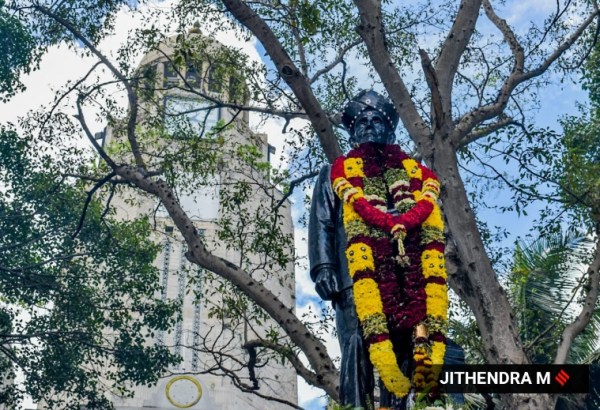 The statue of Sir M Visvesvaraya installed at KR Circle. (Express photo by Jithendra M)
The statue of Sir M Visvesvaraya installed at KR Circle. (Express photo by Jithendra M)
Maintained by the BBMP, the chowka consists of boards carrying famous quotes of Visvesvaraya. The chowka also has a mini library consisting of books related to mechanical engineering, civil engineering, and Bengaluru roads among others.



